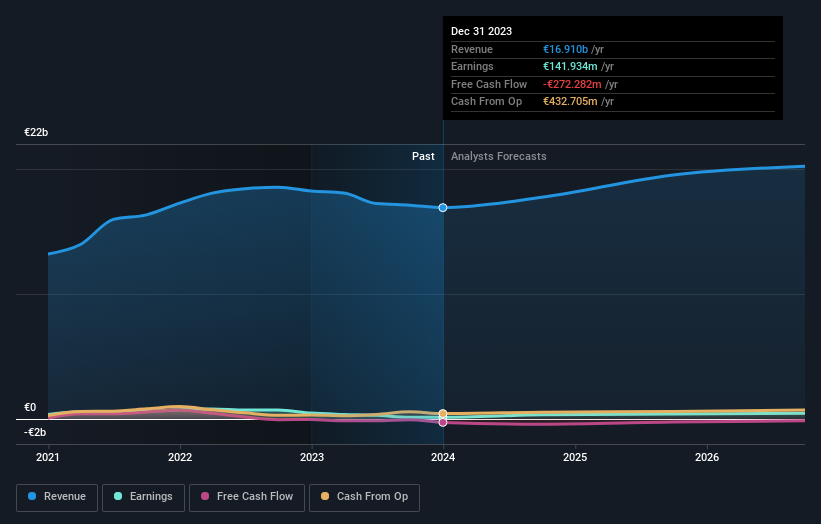Stock Analysis
- Germany
- /
- Metals and Mining
- /
- XTRA:NDA
While public companies own 31% of Aurubis AG (ETR:NDA), individual investors are its largest shareholders with 44% ownership

Key Insights
- Aurubis' significant individual investors ownership suggests that the key decisions are influenced by shareholders from the larger public
- A total of 11 investors have a majority stake in the company with 50% ownership
- Institutional ownership in Aurubis is 25%
If you want to know who really controls Aurubis AG (ETR:NDA), then you'll have to look at the makeup of its share registry. And the group that holds the biggest piece of the pie are individual investors with 44% ownership. In other words, the group stands to gain the most (or lose the most) from their investment into the company.
Public companies, on the other hand, account for 31% of the company's stockholders.
In the chart below, we zoom in on the different ownership groups of Aurubis.
Check out our latest analysis for Aurubis

What Does The Institutional Ownership Tell Us About Aurubis?
Many institutions measure their performance against an index that approximates the local market. So they usually pay more attention to companies that are included in major indices.
We can see that Aurubis does have institutional investors; and they hold a good portion of the company's stock. This suggests some credibility amongst professional investors. But we can't rely on that fact alone since institutions make bad investments sometimes, just like everyone does. If multiple institutions change their view on a stock at the same time, you could see the share price drop fast. It's therefore worth looking at Aurubis' earnings history below. Of course, the future is what really matters.

Hedge funds don't have many shares in Aurubis. Looking at our data, we can see that the largest shareholder is Salzgitter AG with 31% of shares outstanding. For context, the second largest shareholder holds about 3.1% of the shares outstanding, followed by an ownership of 3.1% by the third-largest shareholder.
After doing some more digging, we found that the top 11 have the combined ownership of 50% in the company, suggesting that no single shareholder has significant control over the company.
While it makes sense to study institutional ownership data for a company, it also makes sense to study analyst sentiments to know which way the wind is blowing. Quite a few analysts cover the stock, so you could look into forecast growth quite easily.
Insider Ownership Of Aurubis
The definition of company insiders can be subjective and does vary between jurisdictions. Our data reflects individual insiders, capturing board members at the very least. Management ultimately answers to the board. However, it is not uncommon for managers to be executive board members, especially if they are a founder or the CEO.
I generally consider insider ownership to be a good thing. However, on some occasions it makes it more difficult for other shareholders to hold the board accountable for decisions.
Our data cannot confirm that board members are holding shares personally. It is unusual not to have at least some personal holdings by board members, so our data might be flawed. A good next step would be to check how much the CEO is paid.
General Public Ownership
With a 44% ownership, the general public, mostly comprising of individual investors, have some degree of sway over Aurubis. This size of ownership, while considerable, may not be enough to change company policy if the decision is not in sync with other large shareholders.
Public Company Ownership
We can see that public companies hold 31% of the Aurubis shares on issue. We can't be certain but it is quite possible this is a strategic stake. The businesses may be similar, or work together.
Next Steps:
I find it very interesting to look at who exactly owns a company. But to truly gain insight, we need to consider other information, too. Case in point: We've spotted 3 warning signs for Aurubis you should be aware of.
Ultimately the future is most important. You can access this free report on analyst forecasts for the company.
NB: Figures in this article are calculated using data from the last twelve months, which refer to the 12-month period ending on the last date of the month the financial statement is dated. This may not be consistent with full year annual report figures.
Valuation is complex, but we're helping make it simple.
Find out whether Aurubis is potentially over or undervalued by checking out our comprehensive analysis, which includes fair value estimates, risks and warnings, dividends, insider transactions and financial health.
View the Free AnalysisHave feedback on this article? Concerned about the content? Get in touch with us directly. Alternatively, email editorial-team (at) simplywallst.com.
This article by Simply Wall St is general in nature. We provide commentary based on historical data and analyst forecasts only using an unbiased methodology and our articles are not intended to be financial advice. It does not constitute a recommendation to buy or sell any stock, and does not take account of your objectives, or your financial situation. We aim to bring you long-term focused analysis driven by fundamental data. Note that our analysis may not factor in the latest price-sensitive company announcements or qualitative material. Simply Wall St has no position in any stocks mentioned.
About XTRA:NDA
Flawless balance sheet with reasonable growth potential.


